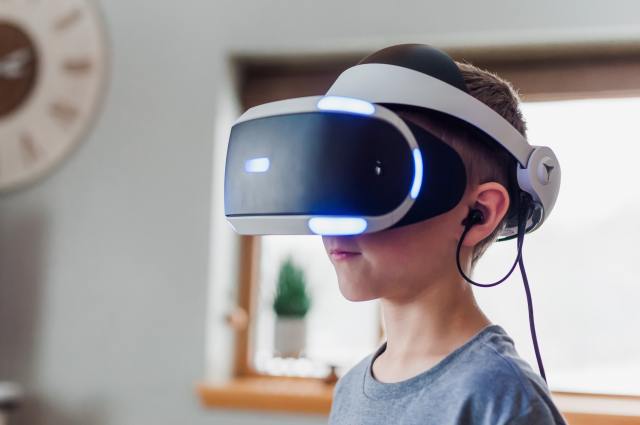
Virtual reality-based therapy for people on the autism spectrum has arrived, and it brings with it more possibilities for growth and learning for this segment of the population. Already in use in home, clinical and school settings, VR has proven to be an effective means of teaching social, behavioral, communication and other skills at which many individuals with autism are working hard to develop. Such skills can be practiced and reinforced as often as is warranted, allowing the learner to move forward at his own pace and in his own good time. And, as is often the case with technology-assisted learning, the process is engaging and fun.
The start-up company that pioneered this concept of bringing together VR technology and therapeutic content for those with autism and related diagnoses is a company called Floreo Technologies. Vijay Ravindran, the CEO and co-founder of Floreo, has a child with autism. A few years ago when he observed how strongly virtual reality technology resonated with his child, Vijay started to contemplate how VR could be leveraged to address the challenges his child was confronting at the time, and the vision of Floreo was born.
Today, Floreo offers a growing content library of more than 175 lessons which is available to parents, teachers and clinicians who work with and care for people on the autism spectrum. Additional content will soon be released for those contending with Attention Deficit Hyperactivity Disorder (ADHD) and anxiety disorders, which often coexist with autism. Some of Floreo’s clients include the Sarah Dooley Center for Autism in Richmond, Va., the Manhattan Children’s Center in New York City, the Region 10 School Districts in Texas, the Cuyahoga County Board of Developmental Disabilities in Cleveland, Ohio and the California PsychCare behavioral health clinic in Chatsworth, Calif.
Why use virtual reality as a vehicle for the delivery of therapeutic content for individuals with autism? For starters, those who live in areas in which there are few if any clinicians experienced in working with people with autism now have access to the help they deserve as they learn and grow. The learner (an individual with autism) can work with the content in his own home under the supervision of a parent.
VR is particularly effective at helping the learner develop a skill within the context of the situation to which the skill is directly relevant. It does so by simulating real world environments in which skills can be practiced and refined until they are mastered. For example, modules that teach skills as to how to appropriately and safely interact with police take place in an animated setting that involves live, uniformed police officers who approach and talk to the learner alongside a city street.
Modules that teach social skills that are applicable to school environments involve interactions with animated kids sitting at desks or tables in a classroom with the teacher up front, schoolmates initiating conversations with the learner while walking down a hallway, hanging out by the lockers or sitting at a table in the cafeteria, etc. As the learner immerses herself in the virtual setting and interacts with the animated individuals, a supervising teacher, clinician or parent directs her through the exercise using written guidance which the VR software provides. The learner wears a headset while the supervisor works off a tablet. Both devices are synchronized to ensure that they are always working in lock step with each other.
Sensory sensitivities are prevalent among many on the autism spectrum. Accordingly, the animations and art Floreo uses in its simulated environments are simplified, allowing the learner to focus on the skill he is learning without distraction. Furthermore, each exercise is streamlined to emphasize a single objective, free of excess, keeping the exercise short, sweet and easily digestible.
If only this technology had been available to me during my formative years. Unaware of my spectrum profile (I wasn’t diagnosed until age 40) but acutely aware of my auditory processing learning disability, I could really have used the help back then. I would have immediately been drawn to virtual reality and enjoyed using it granted my passion as a young boy for all kinds of electronic gadgets, so my parents would have been spared of having to repeatedly tell me to practice the learning modules. Had I learned then from Floreo what I know now, I probably would have been spared of having to learn many of the social skills I eventually acquired the hard way, and I would have learned many of these skills sooner than I actually did.
One day growing up in New Jersey when I was haphazardly crossing a busy street on my bike, I literally came within just a few feet of being run over and probably would have had it not been for the alertness of the driver and the brakes in his car doing their job. I can’t help but wonder if this near-death experience, permanently seared into my memory cells, would have been averted if I had previously immersed myself in the Floreo learning module that teaches how to properly cross a busy street. I wonder how my social life in and outside of school may have played out differently if I had access to the social sense learning modules at the time. Would those clinical experiences of mine which fell short of expectations have had more desirable outcomes with VR technology in the mix? Without question!
It all comes down to the importance of people with autism and other neurodivergent individuals being given options as to how they can best learn and grow, and how they can access the help they may want in working to diminish or conquer particular challenges. The list of such options just got longer thanks to the advent of virtual reality and the work companies like Floreo has done in fusing this technology with skill-building content which many on the autism spectrum will find valuable.











